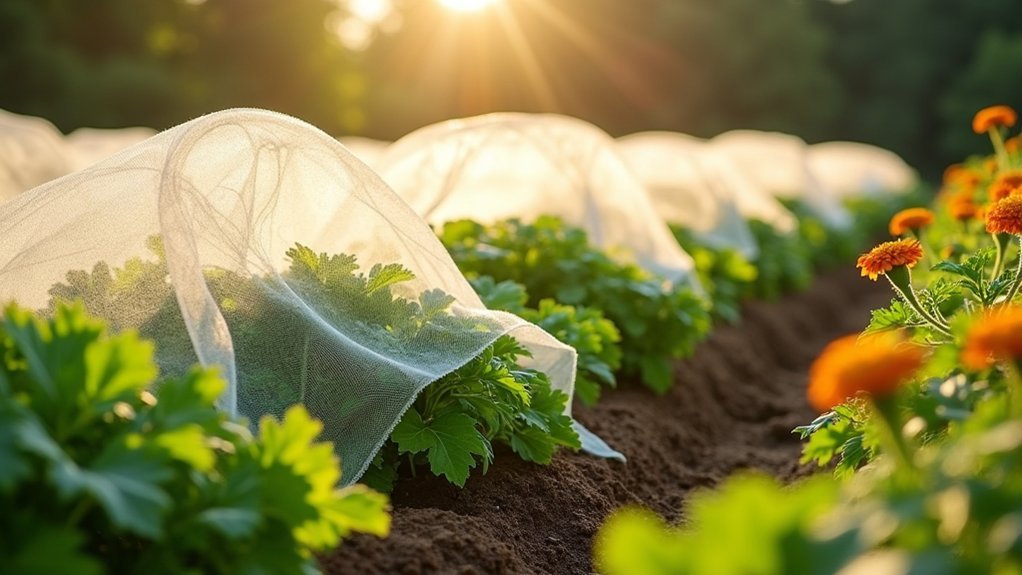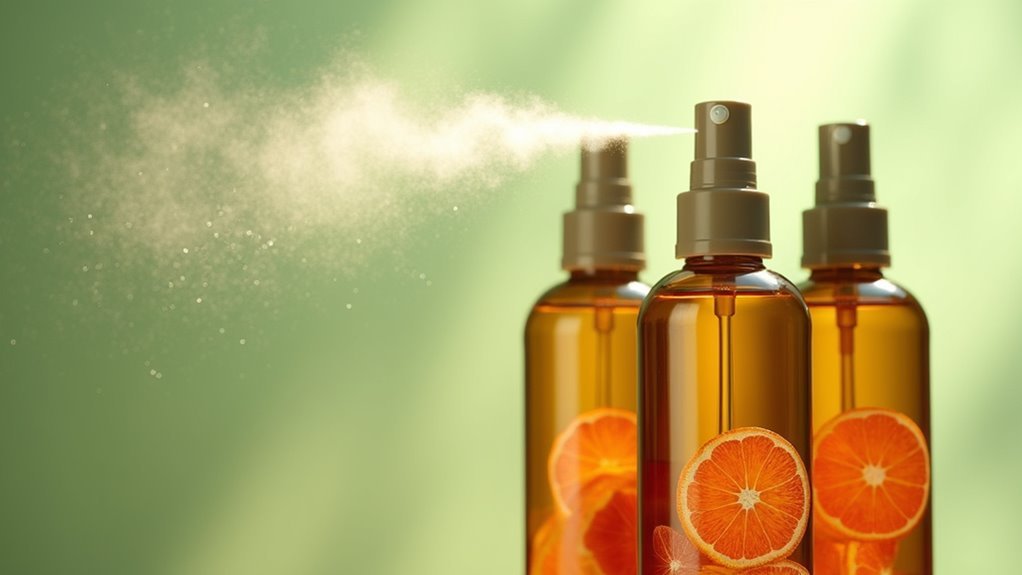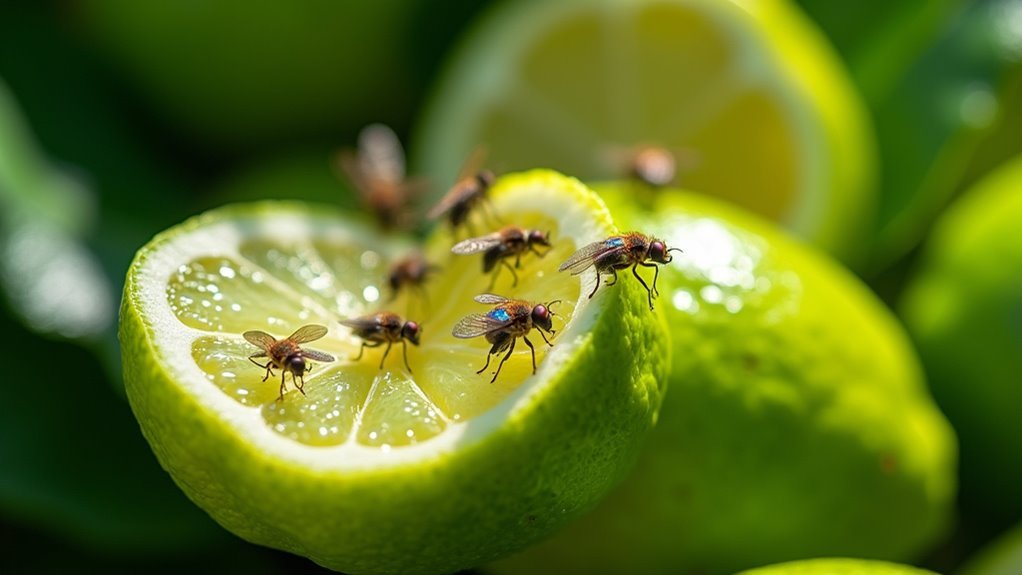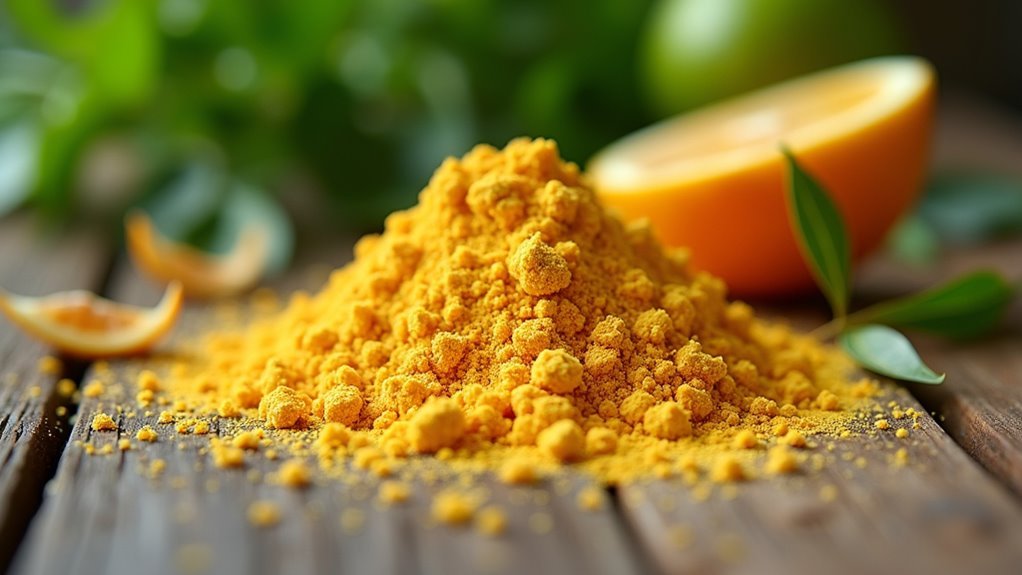You’ve worked hard on your organic garden, but those persistent pests threaten all your efforts. While maintaining organic standards, you still need effective protection for your precious plants. Organic farmers face this same challenge daily and have discovered reliable food-grade insect barriers that keep crops safe without compromising principles. These natural solutions provide powerful protection while remaining environmentally responsible. Let’s explore what the professionals use when chemical options aren’t on the table.
BioAdvanced Organics Tomato, Vegetable & Fruit Insect Spray (24 oz)
For organic gardeners seeking a triple-threat solution, BioAdvanced Organics offers a standout OMRI-listed spray that tackles insects, disease, and powdery mildew in one application. This ready-to-use formula kills aphids, caterpillars, and mealybugs on contact while protecting your edible plants.
At 1.8 pounds and featuring a convenient spray nozzle, you’ll find it easy to apply across vegetables, fruits, herbs, and container gardens. Users praise its effectiveness, lack of offensive odor, and safety during application. While some report limited effectiveness against spider mites and occasional nozzle issues, its 4.3-star rating confirms its reliability for most organic pest control needs.
Best For: Home gardeners looking for an organic, all-in-one solution to protect their edible plants from common pests and diseases without harmful chemicals.
Pros:
- OMRI-listed formula that’s effective against multiple insects like aphids, caterpillars, and mealybugs while also treating powdery mildew
- Ready-to-use spray requires no mixing and is convenient for immediate application on vegetables, fruits, herbs, and container plants
- No offensive odor and safe to use around edible plants with high user satisfaction (4.3-star rating)
Cons:
- Some users report limited effectiveness against spider mites despite claims to control them
- Occasional issues with the spray nozzle functionality have been noted by customers
- At 24 oz, may require frequent repurchasing for larger gardens or severe infestations
BioAdvanced Fruit, Citrus & Vegetable Insect Control Concentrate (32 oz)
Gardeners looking for a hassle-free solution to protect their edible plants will find BioAdvanced’s Fruit, Citrus & Vegetable Insect Control Concentrate particularly effective. With 0.235% Imidacloprid, this 32-ounce bottle treats up to 640 square feet with a simple root application—no spraying needed.
You’ll appreciate the season-long protection from a single application, fighting aphids, whiteflies, and Japanese beetles. It becomes rainproof within an hour by absorbing into the plant system. While highly effective, remember it’s toxic to bees and requires a pre-harvest waiting period. Not available in CT, CO, MD, MA, ME, VT, and some NY counties.
Best For: Home gardeners who want season-long insect protection for fruit trees, citrus plants, and vegetables with minimal effort and no spraying required.
Pros:
- Provides complete growing season protection with just one application
- Simple pour-around-roots application method eliminates the need for spraying
- Effectively controls a wide range of common garden pests including aphids, whiteflies, and Japanese beetles
Cons:
- Highly toxic to bees and other pollinators, raising environmental concerns
- Not available in several states (CT, CO, MD, MA, ME, VT) and restricted in parts of NY
- Requires waiting periods before harvest, ranging up to 21 days for many crops
AntCant-ant Barrier Coating for Repelling Ants
The AntCant-ant Barrier Coating stands out as an ingenious solution for beekeepers and pet owners who need to protect food sources without using harmful chemicals.
Applied to surfaces at 45-degree angles or greater, this coating prevents ants from gaining traction, fundamentally creating an invisible barrier they can’t cross. Users report exceptional results protecting beehives, pet food stations, and hummingbird feeders, even after heavy rain.
Despite its higher cost per ounce, customers value its effectiveness and environmental safety. With a 4.2-star rating, it outperforms traditional methods, though effectiveness may vary with ant species and climate conditions.
Best For: Beekeepers, pet owners, and anyone needing to protect food sources or structures from ant invasions without using toxic chemicals.
Pros:
- Creates an effective physical barrier that prevents ants from climbing surfaces at 45-degree angles or greater
- Long-lasting protection that requires minimal reapplication, even after exposure to rain
- Environmentally friendly alternative to chemical pesticides, making it safe for use around food, pets, and beneficial insects
Cons:
- Higher cost per ounce compared to traditional ant control methods
- May not work effectively against all ant species, particularly Argentine ants
- Performance can vary based on climate conditions and proper application technique
Factors to Consider When Choosing Food-Grade Insect Barriers Even Organic Farmers Swear By
When you’re selecting food-grade insect barriers for your organic garden, you’ll need to verify certification requirements while considering how easily you can apply the product. You should also weigh the protection period against your harvest schedule, check plant compatibility across your garden varieties, and assess potential impacts on beneficial pollinators. The best barriers will meet organic standards while effectively protecting your crops without harming the ecosystem you’ve worked to nurture.
Certification Requirements
Understanding certification requirements should be a top priority if you’re serious about using truly food-safe insect barriers in your garden or farm. Look for products that comply with USDA organic standards, which verify they’re free from synthetic chemicals and safe for edible crops.
Check for OMRI listings—these confirm that products meet strict organic guidelines and are approved for organic production. Pay attention to ingredient transparency; properly certified products will provide thorough documentation showing their natural origins and manufacturing processes.
The best insect barriers undergo rigorous efficacy testing to prove they work while leaving no harmful residues on your produce. These certifications aren’t just paperwork—they’re your assurance that what you’re using aligns with sustainable farming practices and maintains the integrity of your organic growing efforts.
Application Methods
Selecting the right application method can make the difference between effective pest management and wasted effort with food-grade insect barriers. Products vary considerably in how they’re applied—some require direct spraying on plants, while others need to be mixed with water and applied to the soil around roots.
Consider the specific barrier design. Some coatings work best when applied at particular angles to prevent insects from climbing surfaces, creating protection without direct contact. Environmental conditions also impact effectiveness; rain and humidity affect adhesion and functionality.
Don’t overlook application frequency. While some barriers offer long-lasting protection with a single treatment, others require regular reapplication based on pest pressure and weather conditions. Check whether your chosen barrier provides rainproof protection and how quickly it becomes effective after drying.
Residual Protection Period
The longevity of your insect barrier determines its ultimate value and effectiveness in your organic farming operation. Most food-grade barriers offer protection ranging from a few days to several weeks, depending on their formulation.
When selecting a barrier, consider whether you need immediate protection or can wait for activation periods that typically result in longer-lasting effects. Diatomaceous earth provides immediate action but requires frequent reapplication after rain, while neem oil-based barriers may take 24 hours to activate but can protect for up to two weeks.
Remember that environmental factors greatly impact durability—high rainfall areas may require more frequent application regardless of product claims. Also, match your barrier to your target pests, as residual effectiveness varies greatly between different insect species.
Plant Compatibility Range
While many insect barriers claim universal application, successful organic farmers know that matching barriers to specific plant types greatly impacts their effectiveness. The best barriers offer versatility across vegetables, fruits, herbs, and ornamentals without compromising protection quality.
When selecting your barrier, check if it targets the specific pests threatening your crops—aphids, caterpillars, and whiteflies require different protective approaches. You’ll want a formulation that’s safe for edible plants, ensuring your harvest remains untainted.
Consider your plants’ growth stages as well. Some barriers work better on seedlings, while others protect mature plants more effectively. Finally, evaluate your garden’s environmental conditions—humidity and temperature greatly affect how barriers interact with different plant species. Matching these factors to your specific crops will maximize your protection investment.
Pollinator Impact Assessment
Beyond plant compatibility, pollinator safety represents a core consideration when selecting food-grade insect barriers. Many conventional insecticides, particularly those containing Imidacloprid, pose significant threats to bees and other beneficial insects essential for crop production.
When evaluating options, prioritize OMRI-listed products typically endorsed by organic farmers. These formulations deliver effective pest control while minimizing harm to pollinators that support approximately 35% of global food crops. Remember, healthy pollinator populations directly impact your garden’s productivity.
Timing your applications strategically makes a substantial difference. Apply treatments during evening hours when bee activity decreases, and avoid flowering periods when pollinators are most active. This approach, combined with selective product choices, creates a balanced ecosystem where both pest management and pollinator protection coexist—something the EPA increasingly emphasizes in sustainable agriculture guidelines.
Frequently Asked Questions
How Long Before Harvest Should I Stop Applying These Barriers?
Stop applying insect barriers at least 24 hours before harvest. You’ll want to follow each product’s specific instructions as waiting periods vary. Always rinse your produce thoroughly before consumption for safety.
Can These Products Be Used on Indoor Herb Gardens?
Yes, you can use food-grade insect barriers on indoor herb gardens. They’re safe for enclosed spaces and won’t harm your plants. Just apply them sparingly and guarantee proper ventilation in your growing area.
Are These Barriers Safe Around Bees and Beneficial Insects?
Most food-grade insect barriers are designed to be safe for beneficial insects like bees. You’ll find they’re selective in their targets, but it’s always best to apply them when pollinators aren’t active.
Do These Barriers Work Against Fruit Flies and Gnats?
Yes, food-grade insect barriers can work against fruit flies and gnats. You’ll find they create physical obstacles these tiny pests can’t easily penetrate. They’re especially effective around ripening fruits and damp soil areas.
How Often Should Barriers Be Reapplied After Rain?
You’ll need to reapply food-grade insect barriers immediately after heavy rain. For light showers, wait until surfaces dry completely. Most products require reapplication every 7-14 days during rainy seasons for ideal protection.





Leave a Reply